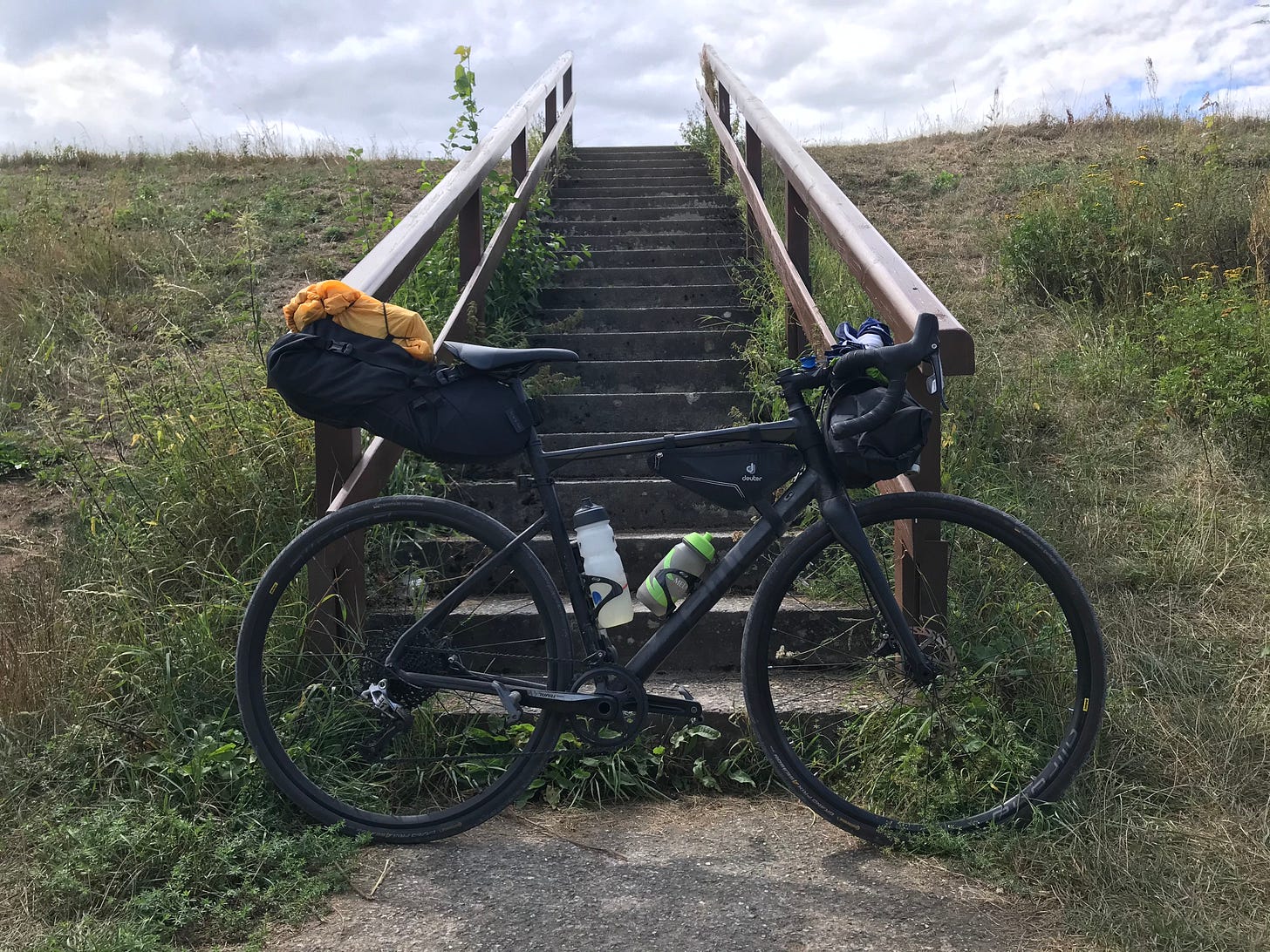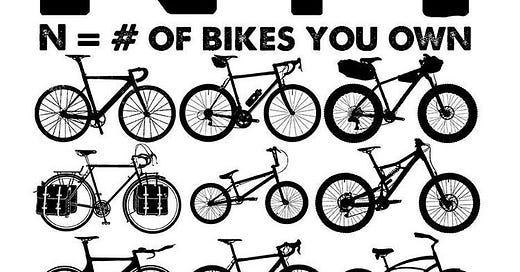Last week, I had a bike fit. My second-ever bike fit, actually. I got one for the first time right about two years ago, shortly before I took the plunge on my titanium Bearclaw Thunderhawk custom build.
See, while I’m not so naive as to suppose I’ll never buy another bike…
…part of the idea behind spending a lot of money on titanium is that it is a “forever frame.” I may swap parts on it over time, but the frame itself is pretty bombproof.
So I wanted to make sure it fit me well! That means frame size, geometry numbers, all of it - I wanted the bike to fit me like a glove.
Why, then, did I get another fit? Well, let’s get into it.
The More You Ride
I suppose it’s true with a lot of hobbies that the more you get into them, the more particular you become. Soccer players and cleats. Chefs and knives. Guitarists and strings.
When you start riding bikes, a “fit” mostly amounts to setting the saddle at roughly the right height and going. Why? Because that’s probably the biggest (and easiest) change to make, and if you’re only going five or ten miles the effects of having it wrong are pretty negligible. Certainly not unnoticeable - I remember a time as a teen where I got a horrifically sore bum from riding a too-high saddle just a few miles on two or three successive days. But also easily remedied - I dropped it a couple inches, and suddenly my legs could support me through the entire pedal stroke.
The principle extends pretty far, though. As long as you aren’t on a wildly large or small frame and your position is kind of correct, you can probably do a few 20-60 mile rides per week without too much discomfort. Any good local bike shop should do this sort of super basic fit for you when you buy a bike, and now there are also several apps that can get you into the neighborhood of a correct fit at home.
All that said, as you start to push more consistency and longer distances, the small inefficiencies really start to compound. Maybe it’s numb hands when you go more than four hours. Or a twinging knee on any second consecutive day of riding.
I started really noticing things when I went from riding 50-100km in the mountains, where my body position relative to the center of the bike was constantly changing as I went uphill and downhill and in and out of the saddle, to longer rides on flatter terrain where I was more locked into a constant position, trying to output constant power.
All that said, even if you’re going shorter distances, a bike fit can be a good idea to address comfort issues, improve power, or especially before buying a new bike.

My First Fit - Narrowing the Range
Different bike fitters will have different ideas about how best to optimize a rider’s fit on the bike. They’ll have slightly different methodologies, target slightly different positions, but all of the good ones will listen closely to your goals and riding style, and they’ll work with you towards those ends.
Bike fits aren’t static, though. A rider’s strength and flexibility will increase and decrease over time. Bodies change. Adjustments are needed.
Typically, though, if your fit is pretty good, an “adjustment” will be relatively cheap and easy, like changing a stem or adjusting saddle position. My primary goal going into my first fit was simply to make sure I was riding the right size bike, because those smaller adjustments only work if the big picture (the frame) is in the right ballpark.
At 5’10”, I’m often very near the cutoff between brands’ recommended sizes. Although there can be a HUGE difference between one brand’s frame of a given size and another’s (or between the race and endurance frames of a single brand), most of them will put me somewhere between a size 54 and 56, or even between a size 56 and 58 frame.
The thing is, relying on brands’ fairly arbitrary size designations can be pretty deceiving. Instead, my first fit helped me find stack and reach measurements that fit my body, which I could then use across brands to find the size bikes likely to fit me. Yes, these numbers will change some as you move from an endurance bike fit, to a race fit on one end of the spectrum or (especially) a mountain bike fit on the other end, but it’s a good starting point. Saddle and handlebar adjustments can fine-tune a fit, but they need to work from a good foundation.
That first fit certainly made adjustments to those other details to try to optimize my position on the bike, but confirming what the right size frame for me was before buying a bike I hoped to have for years was essential.
So Why The New Fit?
As I said above, different fitters will have different opinions, and bodies change over time. After two years on my old fit, I’d already begun to experiment with tweaks on my own, particularly after some growing minor issues in my shoulders and feet.
Although I had a good experience with my first fitter, I decided to go somewhere new this time precisely to get a new set of eyes on my fit.
This time, I was able to give my fitter an even more precise description of the kind of fit I was seeking: yes, I’ll do some moderately quick group rides or the occasional gravel race, but my primary focus (far more even than it was in early 2023) is bikepacking, randonneuring, and ultra racing.
Across approximately three hours of discussion and testing, we reviewed my fit needs, including current problem areas, and set out to start addressing them.
One of the tweaks I’d already been trying was to move my saddle forward a bit to try to get my pedal stroke more centered over the bottom bracket. After watching me pedal and checking some biometric measurements, we ended up moving the saddle forward significantly (by which I mean at about a centimeter) more. Since this effectively shortens saddle height, my saddle also went up a bit to compensate, but we actually went a little further than that to try to take any excess weight off my foot at the bottom of the pedal stroke and thereby relieve the numbness I’ve been getting in my toes.
I’m still testing how effective this change was for my toes - bike fitting is an iterative process that often requires a followup session or two after some real-world road experience - but the move to be more over the BB feels good.
The other major change we made was on the front end of the bike. My prior bike fit stretched me out relative to the position I’d gone in with, including a 10mm longer stem. As I said earlier, different fitters will bring different philosophies into the session. My 2023 fit wasn’t wrong, it just put me in a more aggressive position. It wasn’t so extreme that it stopped me from being comfortable on endurance rides, but I do suspect that it was a contributing factor to my neck issues during the 2024 Mishigami Challenge.
So, even with the saddle moved forward, I’mm currently trialing a 100mm stem as opposed to the 110mm one I had been running. However, we also compromised a bit by dropping my stack height a few millimeters. The hope is that this will allow me to get low over the front of the bike when I want to, but give me an endurance position that requires less work from my upper body to hold. Like the other changes, this is one that will take a couple months of real world (i.e. outside, not on the trainer) testing to see how I get along.
There are absolutely some changes that feel better straight away, and that’s an important part of bike fitting. But your body is also used to moving while in a certain position on your bike, so it can take some time for a new position to feel natural, even if it’s better for your goals.
It’s also true that I need to keep working on shoulder strength and mobility to support my own comfort on my bike. I spend time working on core strength plus hip, leg, and knee mobility and stability for the same reasons. Being both stronger and more flexible can help you stay comfortable.
Weather permitting, I’ll be putting all these changes (plus the small ones I haven’t mentioned, like subtle adjustments to my stance width and hood positions) to the test outdoors over the next couple months, and then following up with my fitter to make further iterative changes as needed.
If you’ve never had a bike fit before (and ESPECIALLY if you’re about to buy a new bike), take a look online for reputable fitters in your area and consider going to see one. Even if you think your position is pretty good, you can find a lot of benefit from a professional consultation. It’s well worth the time and money.





